OWC USB-C Travel Dock E
Support Manual
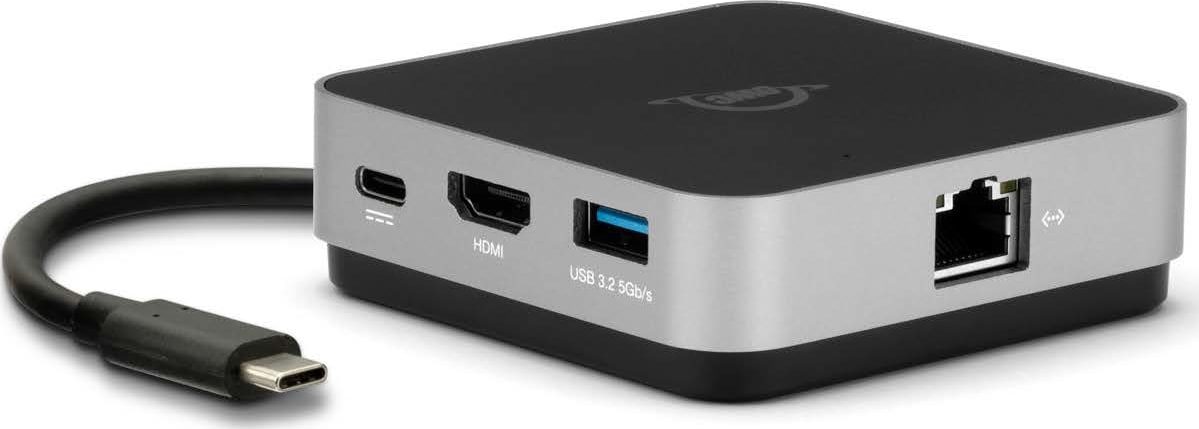
Introduction
1.1 System Requirements
Operating System
- Mac: macOS 10.15 or later
- PC: Windows 10 or later
- Other: iOS, iPadOS, Android, & Chrome OS (latest version recommended)
Hardware
- Works with any Mac, PC, Tablet, & Phone with a Thunderbolt (USB-C) port
Supported Flash Media
- SD (up to 4.0 UHS-II) cards
1.2 Package Contents
- OWC USB-C Travel Dock E with Tethered USB Type-C cable
1.3 Rear Left Side View
- Ethernet port – Connect a Gigabit Ethernet cable.
- SD media slot – Supports SD 4.0 in UHS-II (Ultra High Speed II) with bus speed up to 156 MB/s (full duplex) or 312 MB/s (half duplex).
- USB 3.2 Gen 1 (5Gb/s) Type-A port – Supports USB devices with a Type-A connection.
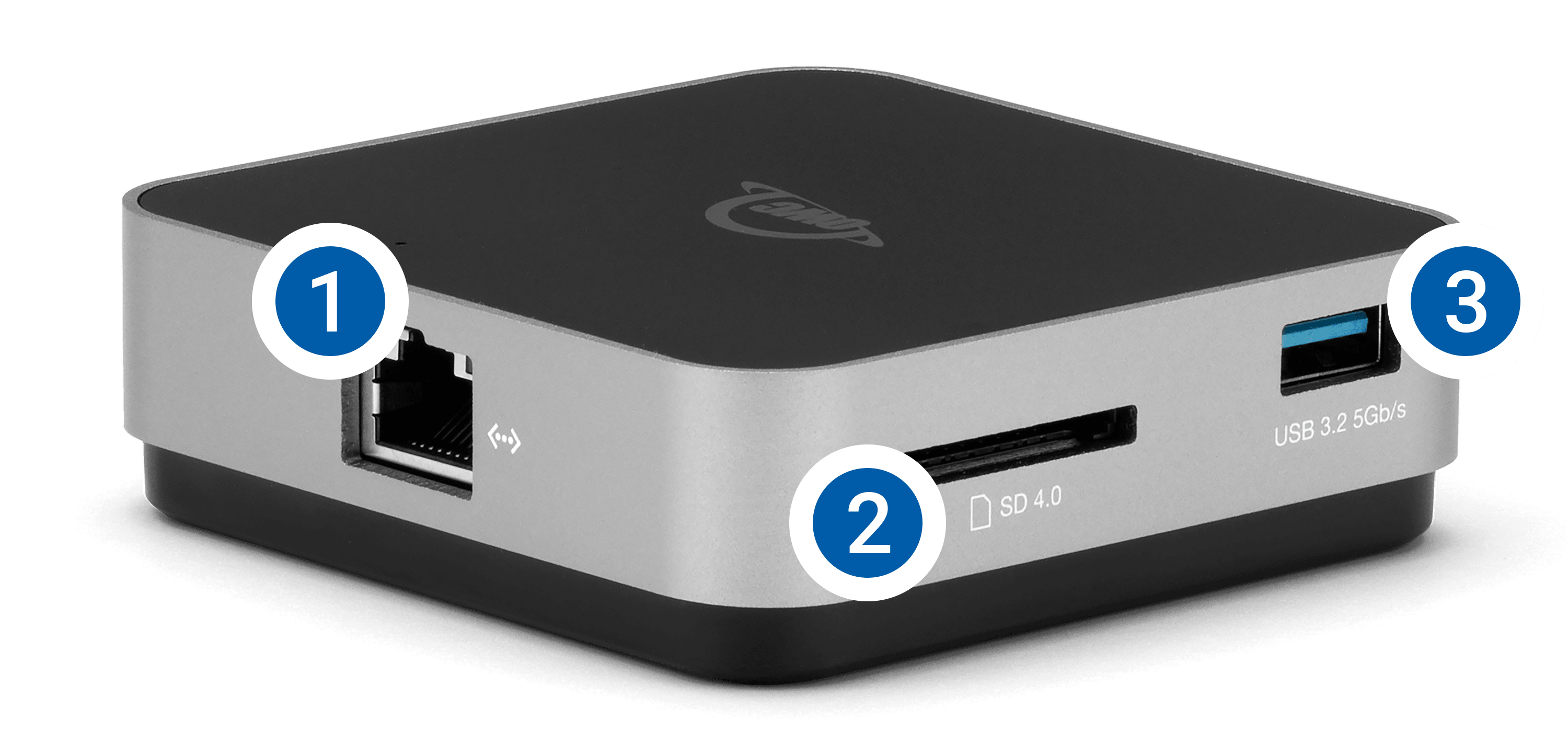
1.4 Rear Right Side View
- USB-C Power Delivery Port – Power delivery / pass-through only – Connect a dedicated USB-C charger to to provide battery charging for the host system, or extra power to the OWC Travel Dock E when multiple devices are connected, including high-power USB devices.
- HDMI 2.0 port – Supports a HDMI display up to 4k @ 60Hz.
- USB 3.2 Gen 1 (5Gb/s) Type-A Port – Supports USB devices with a Type-A connection.
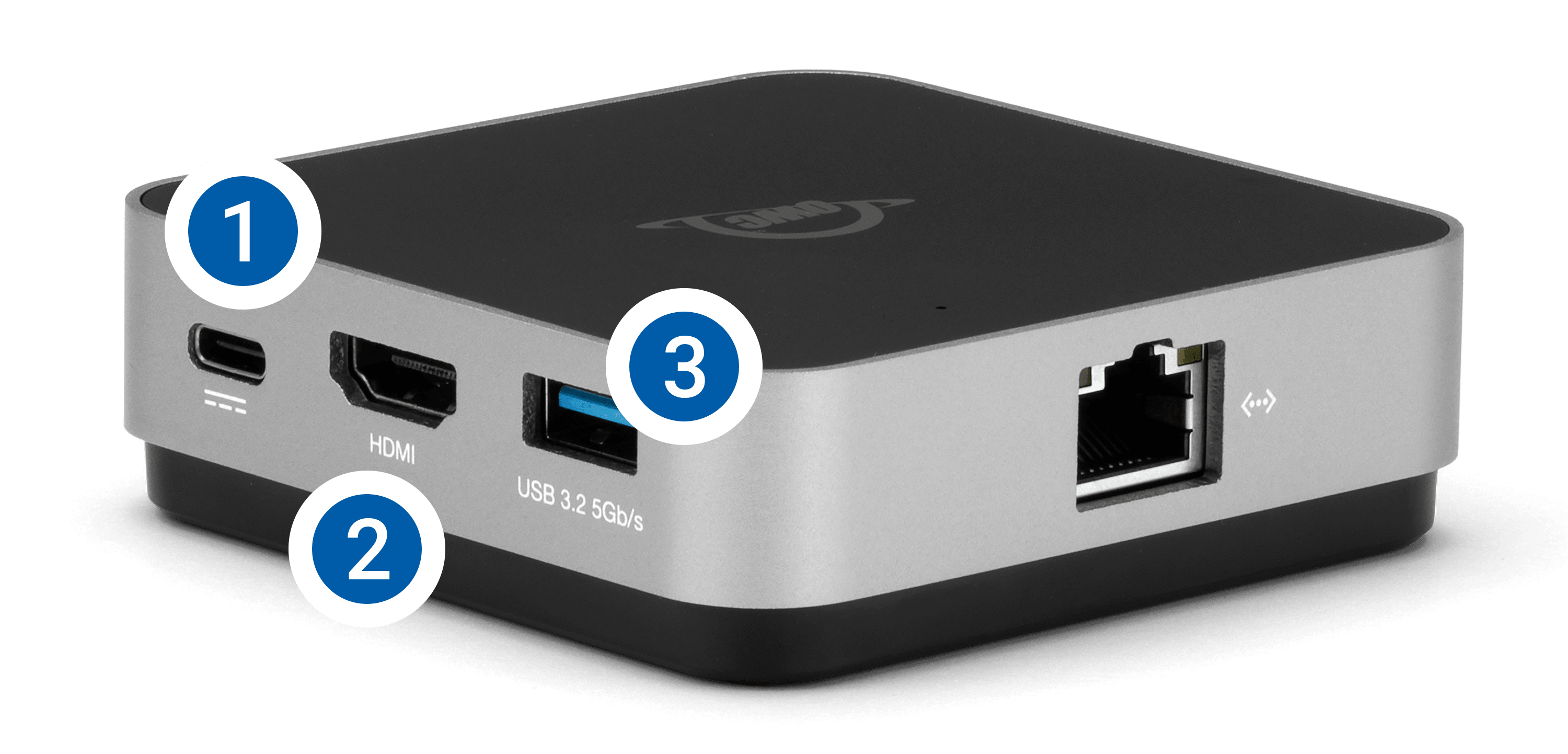
Getting Started
2.1 Removing And Stowing The Tethered Cable
Removing the Tethered Cable
1. Lift up the cable to begin disengaging the cable from the dock.
2. Lift up on the USB Type-C plug to fully disengage the cable from the dock.
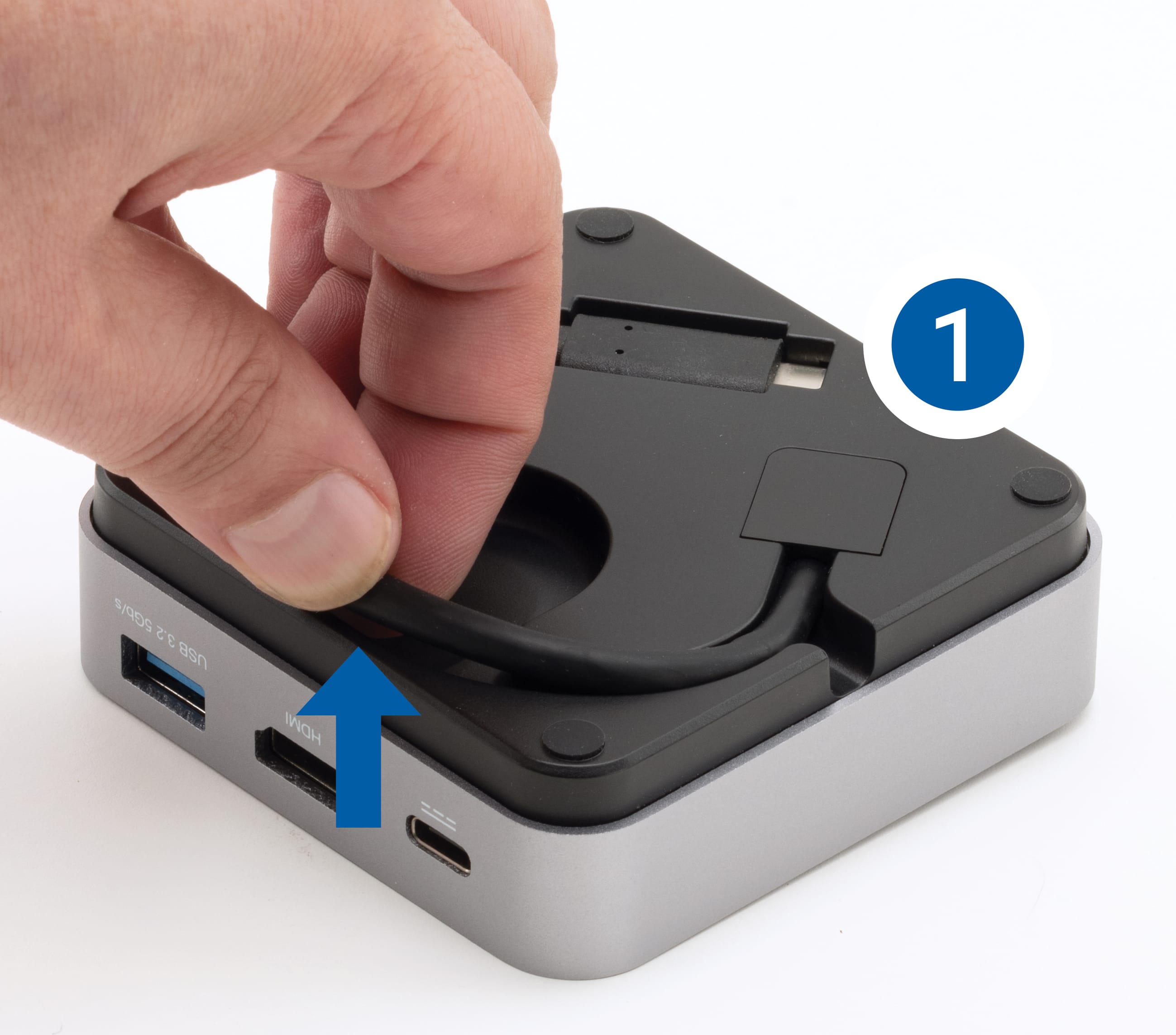
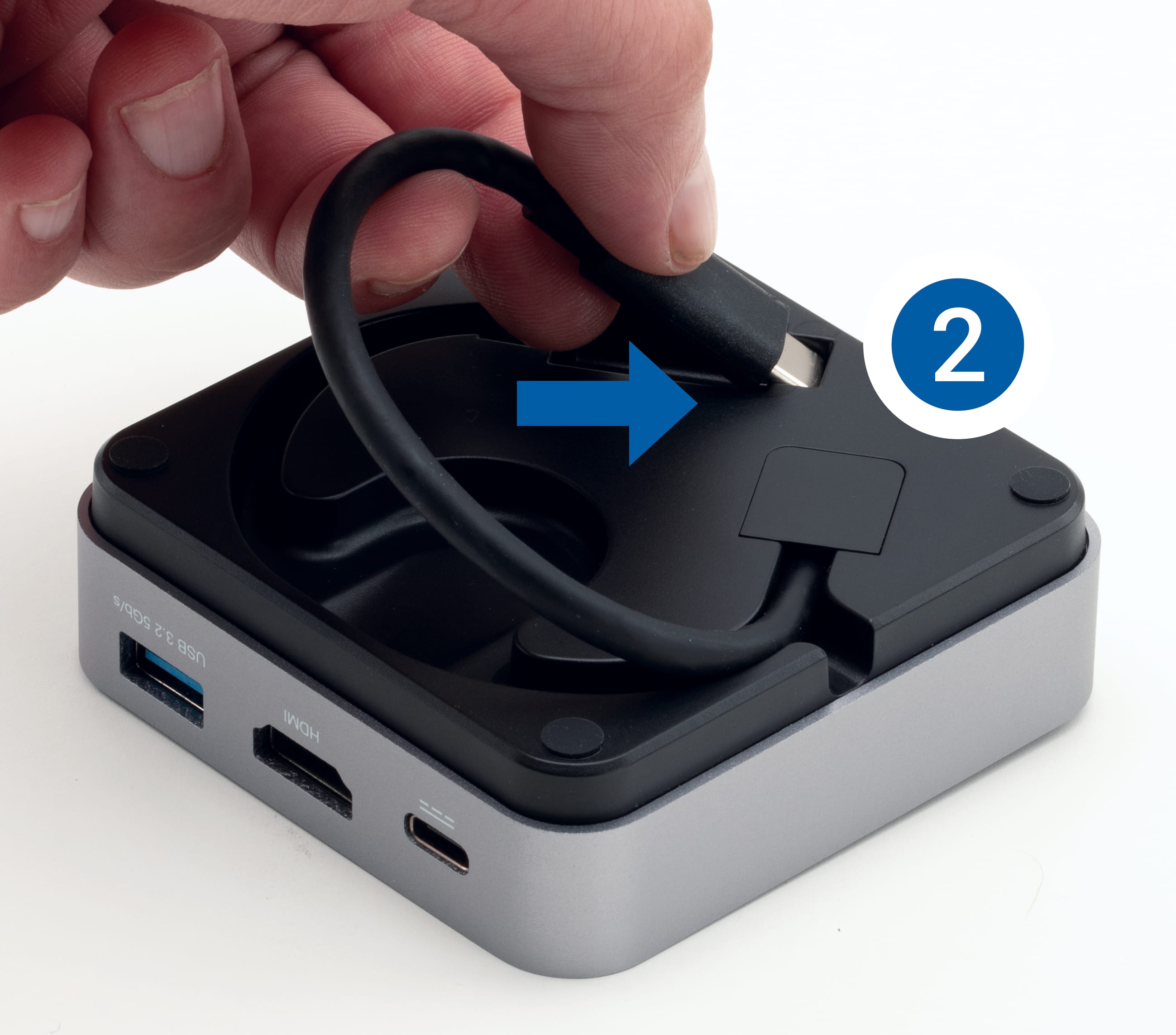
Stowing the Tethered Cable
2. Place the USB Type-C plug into the notch of the dock
3. Press the remaining cable into the groove of the dock

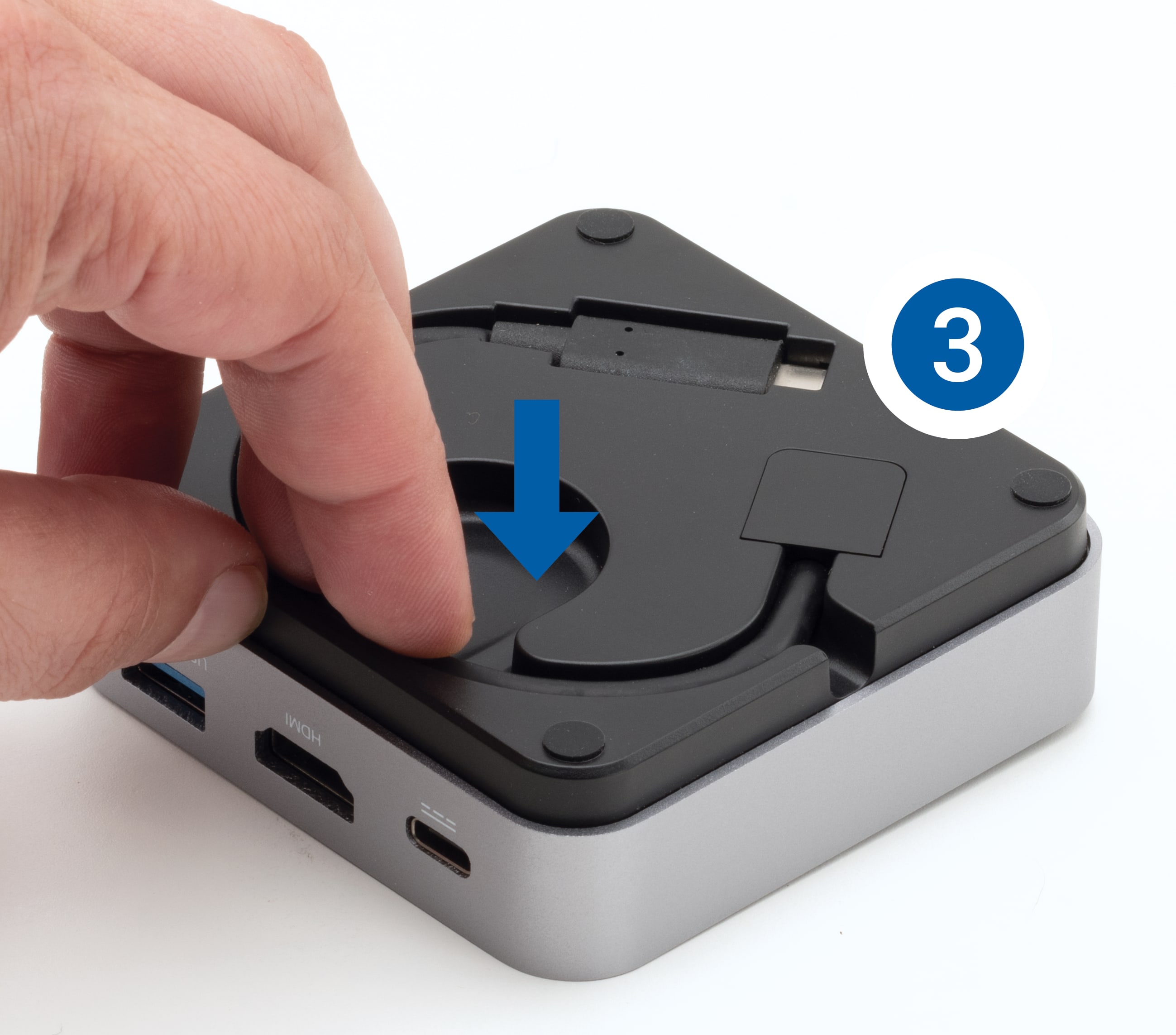
2.2 Device Setup
This section describes the process of connecting the OWC Travel Dock E.
1. Connect the tethered Thunderbolt cable into a system.
2. Connect other devices to the appropriate ports on the dock. All connected devices will be available immediately for use on your system.
3. Download appropriate device drivers.
2.3 Device Drivers
Mac Users
Driver required to enable "Apple Super Drive", "Apple USB Keyboard", and charging for "iPad generations 1/2/3". The driver is packaged with the OWC Dock Ejector application download. Dock Ejector safely ejects all drives connected to the OWC Thunderbolt Pro Dock with a single click. OWC Dock Ejector can be download by visiting: go.owc.com/dockejector. See additional information regarding OWC Drive Ejector in Section 3.2 "Unmounting Drives".
Device Management
3.1 OWC Innergize Software
A software application included with OWC Atlas media cards that currently provides three basic functionalities to the user: Health, Sanitize and Field Firmware Upgradability.
- The Health function allows the user to know how much life is left on their OWC Atlas media card
- Sanitize removes ghost data on OWC Atlas media cards which will allow the media cards to perform at their peak and out of factory condition performance in matter of seconds
- Field Firmware upgradability allows OWC to deliver live updates to our memory cards without the hassle of sending them in for an update.
Installing OWC Innergize
- Download OWC Innergize application based on the system:
- Open the downloaded file to begin and complete the installation process.
- For additional information regarding OWC Innergize please consult the support manual "OWC Innergize User Guide"
3.2 Unmounting Options
To ensure no data is lost during normal use, always eject or unmount the corresponding disk(s) from your operating system before powering off the device. Unmounting options are provided below.
OWC Dock Ejector
This application safely ejects all drives connected to the OWC Travel Dock E with a single click, adding peace of mind to fast-paced mobile workflows. To install this app, please follow the steps below.
NOTE: Enables support for the Apple Super Drive, Apple USB Keyboard, and charging for iPad 1/2/3 generation devices on the dock’s ‘high-power’ ports. This application includes a driver that enables support for these devices and charging functions.
- Download the installer file for Mac or Windows: go.owc.com/dockejector
- Launch the installer and follow the prompts. No restart is required.
- Once the app is running an icon like the one shown below will appear in the macOS menubar, or, System Tray on Windows. Clicking on the icon will provide options to unmount the OWC Gemini.
- Full user manual can be viewed by visiting go.owc.com/dockejector/manual
Manually Unmounting Volumes
macOS
- Drag the icon for the device you wish to unmount to the trash can; OR
- Right-click the device icon on the desktop, then click “Eject”; OR
- Highlight the device on your Desktop and press Command-E.
Windows
- Windows 10 build 1809 (October 2018) or later:
- Eject the drive by clicking the ‘Show hidden items’ menu in the Taskbar, then clicking ‘Safely Remove Hardware and Eject Media’, and last select the ‘Eject’ option for this volume.
- Windows 10 build 1803 and earlier:
- Go to the System Tray (located in the lower right corner of your screen). Click on the “Eject” icon (a small green arrow over a hardware image).
- A message will appear, detailing the devices that the “Eject” icon controls, i.e., “Safely remove...” Click on this prompt.
- You will then see a message that says, “Safe to Remove Hardware.” It is now safe to disconnect the device from the computer.
3.3 Usage Notes
- Mac Users: To enable support for the Apple Super Drive, Apple USB Keyboard, and charging for iPad 1/2/3 generation devices on the dock’s ‘high-power’ ports, please install the Dock Ejector application for Mac. This application includes a driver that enables support for these devices and charging functions. go.owcdigital.com/dockejector
- In most scenarios the dock will draw 8W from its power source. When connected to a power adapter, the dock will draw power from the adapter instead of bus-powering from the host.
- If the media reader or USB peripherals connected to the dock do not perform as expected, connect the dock to a dedicated USB-C power adapter.
- Depending on the adapter connected, the dock can pass up to 92W to the host computer.
- Any power not used by the dock and its ports, is passed to the host for battery charging, if applicable.
- Please note that while both of the USB ports on the OWC Travel Dock E can support ‘high power’ bus-powered USB devices with the appropriate cable type, such as the OWC Envoy Pro EX or the Apple Super Drive, it is not possible to connect two high-power, bus-powered USB devices at the same time, unless you have a dedicated power adapter connected to the dock’s USB-C Power Delivery port.
- Select users may experience “pause-frames” due to the network buffer reaching capacity. The ethernet cable or USB charging port cable should be disconnected from the OWC USB-C Travel Dock E when not in use.
- Please review the “OWC USB-C Travel Dock-E: Pause-Frame Performance Notice” support article for more details.
- Ethernet port may take up to 60 seconds to negotiate a connection when used with iPadOS devices.
- Compatible with the OWC Thunderbolt 3 and Thunderbolt docks (all models).
- No jumbo frame support.
Support Resources
4.1 Troubleshooting
- Verify that the cable connections are secure.
- If issues continue to occur, please know that OWC support is here to help. Contacting support information can be found in Section 4.4. Please have your serial number ready which is located on the bottom of the OWC Gemini and printed on the original packaging.
4.2 Online Resources
- OWC USB-C Travel Dock E Product Page: go.owc.com/traveldocke
- OWC USB-C Travel Dock E Support Guide Page: start.owc.com/traveldocke
- Dock Ejector: go.owc.com/dockejector
- Dock Ejector Manual: go.owc.com/dockejector/manual
- OWC Innergize Support Guide: start.owc.com/innergize
- Innergize Overview Page: go.owc.com/innergize
4.3 About Data Backup
To ensure that your files are protected and to prevent data loss, we strongly suggest that you keep two copies of your data. Any data loss or corruption while using the OWC Travel Dock E is the sole responsibility of the user, and under no circumstances may OWC, its parents, partners, affiliates, officers, employees, or agents be held liable for loss of the use of data including compensation of any kind or recovery of the data.
4.4 Contacting Support
4.5 About This Manual
The images and descriptions may vary slightly between this manual and the unit shipped. Functions and features may change depending on the firmware version. The latest product details and warranty information can be found on the product web page. OWC’s Limited Warranty is not transferable and
General Use Precautions
- To avoid damage, do not expose the device to temperatures outside the following ranges:
- Environmental (Operating)
- Temperature (ºF): 41º — 95º
- Temperature (ºC): 5º — 35º
- Environmental (Non-Operating)
- Temperature (ºF): -4º — 140º
- Temperature (ºC): -20º — 60º
- Environmental (Operating)
- Always unplug the device from the electrical outlet if there is a risk of lightning or if it will be unused for an extended period-of-time. Otherwise, there is an increased risk of electrical shock, short-circuiting, or fire.
- Protect your device from excessive exposure to dust during use or storage. Dust can build up inside the device, increasing the risk of electrical shock, short-circuiting, or fire.
- Do not block any ventilation openings on the device. These help to keep the device cool during operation. Blocking the ventilation openings may increase the risk of electrical shock, short-circuiting, or fire.
Safety Precautions
- Use proper anti-static precautions when handling this device. Failure to do so can increase the risk of electrical shock or short-circuiting.
- Never expose your device to rain, or use it near water, or in damp wet conditions. Never place objects containing liquids on the device, as they may spill everywhere and into the openings. This will increase the risk of electrical shock, short-circuiting, fire, or personal injury.
- To avoid any risk of electrical shock, short-circuiting, fire, or dangerous emissions, never insert any metallic object into the device.
- Please cease use of the device and contact OWC Support if it appears to be malfunctioning.
Terms & Conditions of Sale
Warranty
The OWC USB-C Travel Dock E has a 2 Year OWC Limited Warranty. For up-to-date product and warranty information, please visit the product web page.
Changes
The material in this document is for information purposes only and subject to change without notice. While reasonable efforts have been made in the preparation of this document to assure its accuracy, OWC, its parent, partners, affiliates, officers, employees, and agents assume no liability resulting from errors or omissions in this document, or from the use of the information contained herein. OWC reserves the right to make changes or revisions in the product design or the product manual without reservation and without obligation to notify any person of such revisions and changes.
FCC Statement
Warning! Modifications not authorized by the manufacturer may void the user’s authority to operate this device.
NOTE: This equipment has been tested and found to comply with the limits for a Class A digital device, pursuant to Part 15 of the FCC Rules. These limits are designed to provide reasonable protection against harmful interference when the equipment is operated in a commercial environment. This equipment generates, uses, and can radiate radio frequency energy and, if not installed and used in accordance with the instruction manual, may cause harmful interference with radio communications. Operation of this equipment in a residential area is likely to cause harmful interference, in which case the user will be required to correct the interference at his own expense.
NOTE: This equipment has been tested and found to comply with the limits for a Class B digital device, pursuant to Part 15 of the FCC Rules. These limits are designed to provide reasonable protection against harmful interference in a residential installation. This equipment generates, uses and can radiate radio frequency energy and, if not installed and used in accordance with the instructions, may cause harmful interference to radio communications. However, there is no guarantee that interference will not occur in a particular installation. If this equipment does cause harmful interference with radio or television reception, which can be determined by turning the equipment off and on, the user is encouraged to try to correct the interference by one or more of the following measures:
- Reorient or relocate the receiving antenna.
- Increase the separation between the equipment and receiver.
- Connect the equipment to an outlet on a circuit different from that to which the receiver is connected.
Copyrights And Trademarks
© 2021 Other World Computing, Inc. All rights reserved. OWC and the OWC logo are trademarks of New Concepts Development Corporation, registered in the U.S. and/or other countries. Apple, Mac, mac OS, and SuperDrive are trademarks of Apple Inc., registered in the United States and other countries. Thunderbolt and the Thunderbolt logo are trademarks of Intel Corporation in the U.S. and/or other countries. Microsoft and Windows are either registered trademarks or trademarks of Microsoft Corporation in the United States and/ or other countries. Other marks may be the trademark or registered trademark property of their owners.
No part of this publication may be reproduced, stored in a retrieval system, or transmitted in any form or by any means, electronic, mechanical, photocopying, recording or otherwise, without the prior written consent of OWC.
Free Support Chat
Our free award-winning support team is ready to answer all of your questions. Technical support is available Monday - Friday: 9AM - 6PM. Customer Support & Sales is available Monday - Friday: 9AM - 6PM. Support is unavailable on U.S. Federal holidays. Talk to a human today.

 1-800-275-4576
1-800-275-4576